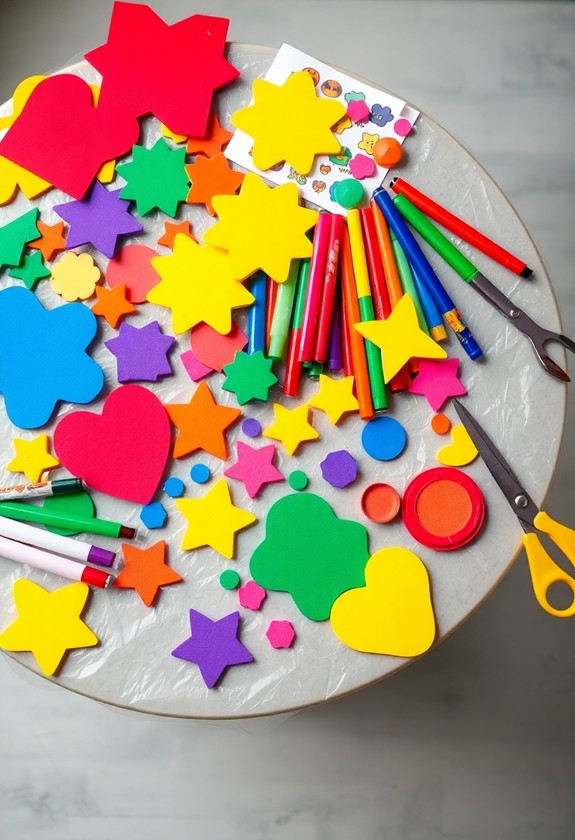Get ready for some messy fun that'll boost your child's motor skills! Finger painting, spaghetti play, and shaving cream canvases are just the start. Why not try mud pies, bubble wrap stamps, or slime squishing? For a real splash, pop paint-filled balloons or investigate cornstarch goop. Ice painting with food coloring is a cool twist, too! These projects aren't just entertaining – they're helping your little one develop important skills. From fine motor control to sensory exploration, each activity offers a unique learning experience. So grab some supplies, lay down some newspaper, and prepare for giggles, learning, and lots of colorful chaos!
Creative Highlights
- Finger painting promotes emotional expression and fine motor skills through tactile exploration of colors and textures.
- Spaghetti sensory play encourages squishing, building, and cutting, developing motor skills and color recognition.
- Shaving cream canvas creations enhance fine motor skills through swirling and mixing, offering a smooth tactile experience.
- Edible playdough sculpting improves fine motor control while engaging children in exploring textures and tastes.
- Paint-filled balloon popping creates vibrant art while enhancing visual perception and motor skills through interactive processes.
Finger Painting Extravaganza
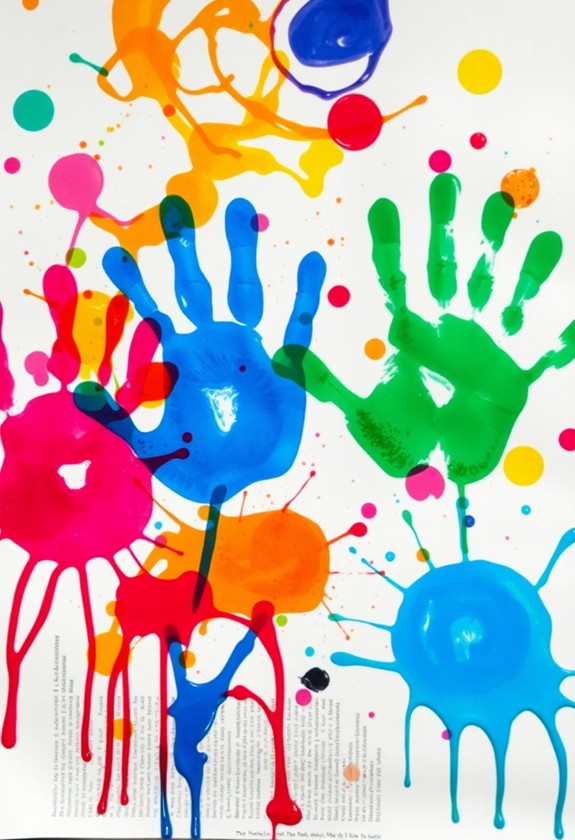
Five lively colors and a blank canvas are all you need for this finger painting adventure. Get ready to unleash your inner artist and make a magnificent mess! Here's how to plunge into:
- Squirt dollops of paint onto a plastic plate
- Roll up your sleeves and wiggle those fingers
- Dip, swirl, and smoosh the colors across your canvas
Let your imagination run wild! Create swirling terrains, dotted masterpieces, or handprint animals. Mix colors to uncover new shades – it's like magic! This sensory exploration promotes emotional expression and stress relief, making it an ideal activity for children of all ages. Don't forget to experiment with different techniques:
- Use your palms for broad strokes
- Try fingertip dots for texture
- Drag your nails gently for fine lines
This tactile experience isn't just fun, it's fantastic for fine motor skills! You'll strengthen those little fingers and improve hand-eye coordination. So go ahead, get gloriously messy, and paint your heart out!
Spaghetti Sensory Play
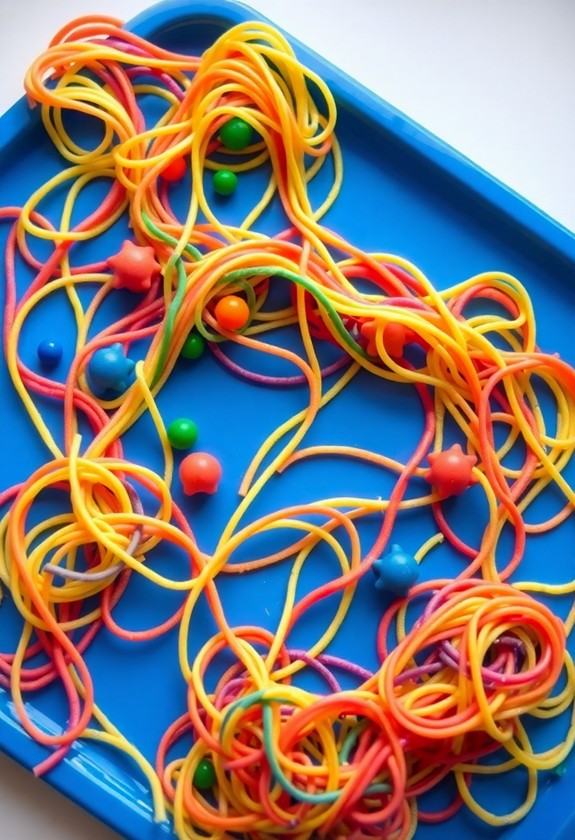
Three simple ingredients transform into a sensory wonderland with spaghetti play. You'll need cooked spaghetti, food coloring, and a large container. Get ready for some noodle-y fun! This activity is perfect for bonding with grandparents and enhancing fine motor skills in a fun, messy environment.
Here's how to set it up:
- Cook the spaghetti until it's al dente
- Divide it into separate bowls
- Add different food coloring to each bowl
- Mix well until the noodles are bright and colorful
Now, let the tactile adventure begin! Encourage your child to:
- Squish the noodles between their fingers
- Make spaghetti "hair" on imaginary heads
- Build spaghetti towers or nests
- Practice cutting the noodles with safety scissors
This pasta-tively amazing activity helps develop fine motor skills, hand-eye coordination, and sensory exploration. Plus, it's a saucy way to learn about colors and textures. Don't forget to snap some pictures of the spaghetti-tacular creations!
Shaving Cream Canvas Creations

From noodles to foam, let's examine another messy masterpiece that'll have your little ones giggling with glee. Shaving cream canvas creations are a sensory delight and motor skill booster rolled into one! This activity not only fosters creativity but additionally improves focus and concentration throughout the crafting process. Grab a shallow tray, some shaving cream, and food coloring. Here's how to get started:
- Squirt a layer of shaving cream onto the tray
- Add drops of food coloring in various spots
- Let your child swirl and mix with fingers or tools
Watch as they create swirling patterns and uncover textures! This activity isn't just fun, it's fantastic for developing fine motor skills. Your little artists will love the smooth, cool sensation of the foam as they create their masterpieces. And clean-up? It's a breeze! Just rinse off in the sink or bathtub. Get ready for a foamy, fantastic time!
Mud Pie Masterpieces
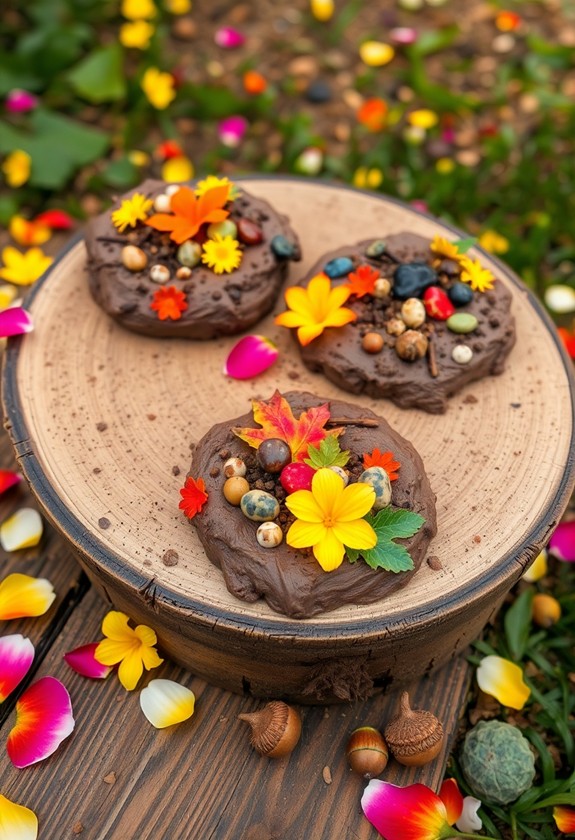
Kids love getting their hands dirty, and mud pie masterpieces are the perfect way to indulge that desire during the development of motor skills. Fine motor skills are crucial for later academic success, and this messy activity provides an excellent opportunity for sensory exploration. Let's plunge into this muddy adventure!
You'll need:
- A large tub of dirt
- Water
- Old kitchen utensils
- Leaves, pebbles, and twigs
Here's how to create your masterpiece:
- Mix dirt and water to make mud
- Shape your mud into pies, cakes, or sculptures
- Decorate with nature's sprinkles (leaves, pebbles, twigs)
Get ready to squish, mold, and pat! Your hands will be working overtime as you craft your muddy creations. And the best part? Clean-up is a breeze – just hose everything down! So go ahead, get messy and have a mud-nificent time boosting those motor skills!
Bubble Wrap Stamp Art
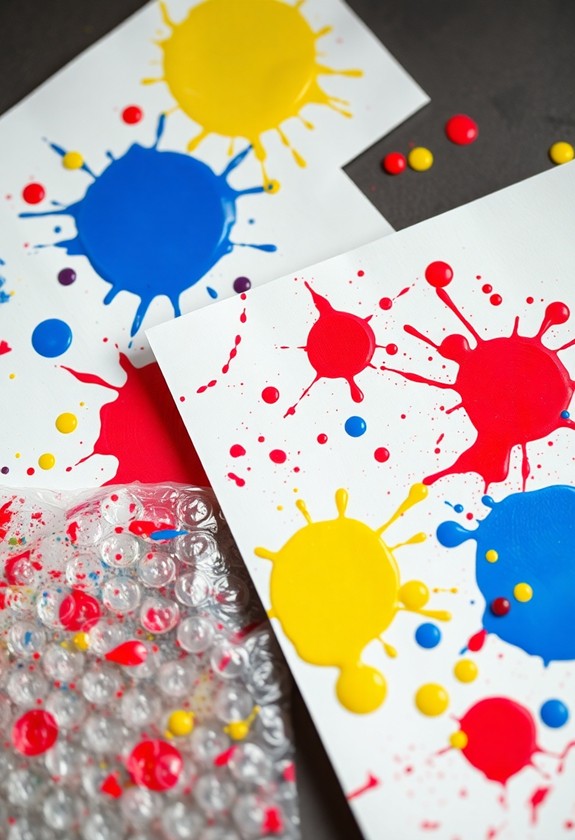
Pop into the world of bubble wrap stamp art, a delightfully messy project that's certain to charm young artists. It's a fun way to create unique textures and patterns as you give those little fingers a workout! This multi-sensory experience aids in memory retention and information processing, essential for early childhood development. Engaging in hands-on craft activities allows for a thorough understanding of the child's abilities and growth areas.
Here's how to get started:
- Gather your supplies: bubble wrap, paint, paper, and a tray
- Pour different colors of paint onto the tray
- Press the bubble wrap onto the paint, then stamp it onto paper
Watch as your child's eyes light up with each satisfying pop and squish! They'll love experimenting with different colors and patterns. But wait, there's more! Try cutting the bubble wrap into shapes for even more creative possibilities. Or, use it to make wrapping paper or cards!
This bubbly adventure isn't just fun – it's fantastic for developing fine motor skills and hand-eye coordination. So, let's get popping and stamping!
Edible Playdough Sculptures

Let's mold our creativity into something tasty! Edible playdough sculptures are a hands-on, mouth-watering way to boost your child's motor skills. Developmental skills like fine motor control and color recognition are improved through this fun, tactile activity. You'll need just a few simple ingredients:
- 1 cup peanut butter
- 2 cups powdered sugar
- 1/3 cup honey
- Food coloring (optional)
Mix everything together, and voilà! You've got edible playdough that's safe to eat and fun to sculpt. Encourage your little artist to roll, squish, and shape the dough into wacky creatures or colorful sceneries. They'll be flexing those finger muscles as they have a blast!
But wait, there's more! This doughy adventure isn't just about creating – it's about investigating textures, colors, and even tastes. Let your child's imagination run wild as they knead, mold, and maybe even sneak a nibble or two. It's a recipe for success and giggles!
Slime Squishing and Stretching

With a squish and a stretch, slime enchants young hands and minds. It's a fantastic way to boost fine motor skills during oodles of gooey fun! You'll love how this squishy substance can be pulled, poked, and molded into all sorts of shapes. Plus, it's super easy to make at home!
Here's why slime squishing is so great for motor development:
- It strengthens finger muscles
- Improves hand-eye coordination
- Augments tactile sensitivity
To get started, mix up a batch of slime using glue, borax, and water. Add food coloring for extra pizzazz! Once it's ready, let your little ones immerse themselves. They can roll it into balls, stretch it into ropes, or flatten it like pancakes. The possibilities are endless! And don't worry about the mess – that's half the fun!
Paint-Filled Balloon Popping

From out of the ordinary comes an explosively fun art project: paint-filled balloon popping. Get ready for a burst of creativity and color! Here's what you'll need:
- Balloons
- Washable paint
- Large canvas or paper
- Safety goggles
- A sharp object (adult supervision required!)
Start by filling balloons with different colors of paint. Tie them up and attach them to your canvas. Now, put on your safety goggles – it's time for the messy magic! Pop those balloons and watch as striking splatters create a unique masterpiece. But wait, there's more! Try these twists:
- Use a dart to pop from a distance
- Mix glitter with the paint for extra sparkle
- Arrange balloons in a specific shape before popping
This paint-tastic activity will have you bursting with joy and improving your hand-eye coordination. Get ready to make a splash in the art world!
Cornstarch Goop Exploration
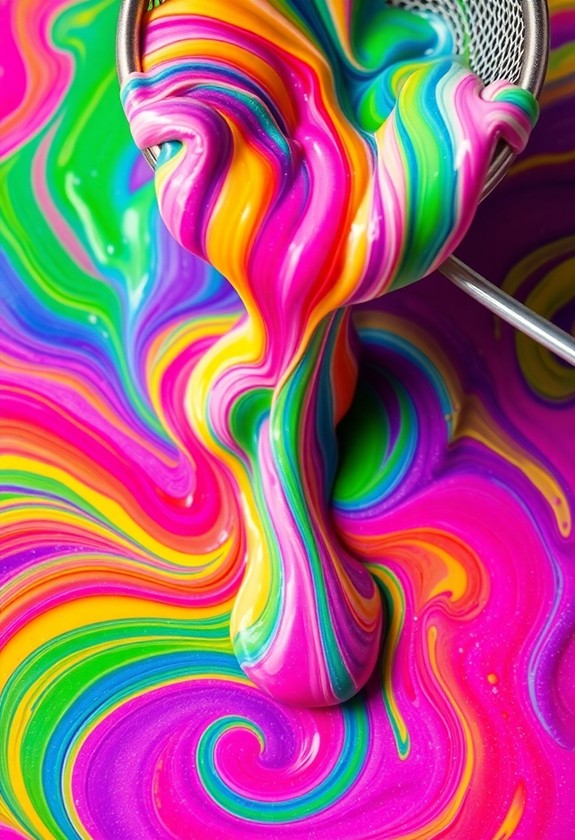
Cornstarch goop, additionally known as oobleck, offers a fascinating sensory experience that's both messy and educational. This unique substance behaves like both a liquid and a solid, making it perfect for motor skill development! You'll love examining its weird properties as you get your hands dirty.
Here's how to make and play with cornstarch goop:
- Mix 2 parts cornstarch with 1 part water in a large container.
- Stir until it forms a thick, goopy consistency.
- Let the fun begin! Squish, squeeze, and pour the goop.
As you play, you'll notice the goop hardens when pressure is applied but flows like liquid when relaxed. It's science in action! Try making goop balls, creating handprints, or even walking on a large batch. This slimy adventure will have you giggling and learning at the same moment!
Food Coloring Ice Painting
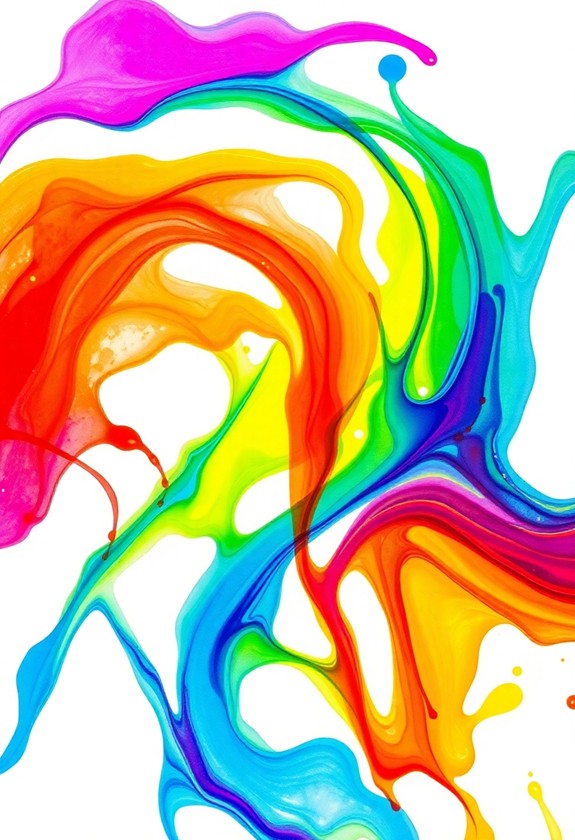
Get ready to chill out with a cool and colorful art project! Food coloring ice painting is a frosty way to create vivid masterpieces during honing your fine motor skills. Here's how to get started:
- Mix food coloring with water in small containers
- Pour the colorful mixtures into ice cube trays
- Freeze overnight
- Pop out your icy paints and let the fun begin!
Grab a sheet of paper and start sliding those colorful cubes across it. Watch as the melting ice leaves behind beautiful, swirling trails of color! You can mix hues, create patterns, or even try painting on different surfaces. As you manipulate the ice, you'll be strengthening those finger muscles and improving coordination. Plus, the chilly sensation adds a whole new dimension to your artistic experience. It's a cool way to express yourself!
Curious Little Questions
How Can I Protect My Furniture During Messy Art Projects?
You don't want your furniture to look like a Jackson Pollock masterpiece, right? Here's how to protect it during messy art projects:
- Cover everything with old sheets or plastic tablecloths
- Use newspaper for quick spills
- Invest in washable drop cloths
- Create a designated "art zone" away from furniture
- Use easels or cardboard barriers
And remember, accidents happen! But with these tips, you'll keep your furniture safe and still have a blast creating messy masterpieces. Let's get artsy!
What Age Group Are These Activities Most Suitable For?
You'll love these activities for kids aged 2-8! They're perfect for little ones developing fine motor skills and older children honing their creativity. Toddlers can investigate textures and colors, as preschoolers engage in more complex projects. Even early elementary students benefit from messy art! Remember, every child develops differently, so don't worry if your little Picasso isn't quite ready. The key is to have fun and get those hands moving! Let's make some beautiful messes together!
Are There Alternatives for Children With Sensory Sensitivities?
You've got plenty of options for kids with sensory sensitivities. Try these fun alternatives:
- Use dry materials like rice or beans for pouring and scooping
- Create art with washable window markers
- Experiment with playdough or kinetic sand
- Draw with chalk on a sidewalk
- Paint with water on dark construction paper
These activities are less messy but still boost motor skills. And hey, they're just as fun! Remember, it's all about finding what works best for your child. Don't be afraid to get creative!
How Do I Remove Stubborn Stains From Clothing After Art Sessions?
Coincidentally, I just tackled this messy problem! Here's how you can zap those stubborn stains:
- Pre-treat with stain remover ASAP!
- Soak in warm water and oxygen-based cleaner
- For paint stains, try rubbing alcohol
- Use dish soap for oil-based marks
- Don't forget to blot, not rub!
And here's a fun tip: make a game out of it! Challenge your kids to a "stain-busting race" – who can remove their stain the fastest? It's a win-win: clean clothes and happy kids!
Can These Activities Be Adapted for Children With Physical Disabilities?
You can adapt these activities for children with physical disabilities. It's all about creativity and inclusivity! Here are some fun ideas:
- Use adaptive tools like paintbrushes with larger handles
- Try mouth-painting or foot-painting techniques
- Set up easels at wheelchair height
- investigate sensory art with textured materials
- Use assistive technology for digital art projects




